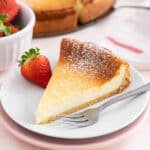German Cheesecake
German cheesecake (Käsekuchen) has a light and fluffy texture and is easy to make. This authentic recipe can be made with or without quark!
Servings: 12 slices
Equipment
Ingredients
For the crust:
- 1 ¼ cup all-purpose flour
- ⅓ cup sugar
- 1 tsp vanilla sugar or vanilla extract
- ¼ tsp salt
- 1 large egg
- 5 Tbsp unsalted butter softened
For the cheesecake:
- 2 large eggs divided
- ¾ cup whipping cream
- 17.6 oz quark or strained Greek yogurt (note 1)
- 1/2 cup sugar
- 1 Tbsp lemon juice
- ¼ cup cornstarch
Instructions
- Preheat the oven to 400 degrees F (200 degrees C). Grease the bottom of a 9-inch springform pan.
- Make the crust. In the bowl of a stand mixer fitted with the paddle attachment, combine all the ingredients for the crust and mix on medium-high speed until a dough forms. Roll out 2/3 of the dough to line the bottom of the pan (sides will be done later). Prick the bottom multiple times with a fork. Then bake the bottom crust (with the sides of the springform attached) for 10 minutes in the lower third of the oven.
- Take the pan out and let it cool down on a cooling rack. Lower the oven temperature to 320 degrees F (160 degrees F).
- Roll the remaining dough into a long sausage and place it around the sides of the pan. Press the dough about 1 inch up the sides of the pan.
- Make the cheesecake filling. Divide the eggs. In a clean bowl, whip the egg whites until soft peaks form. Set aside. Then make whipped cream. In a large bowl, combine quark, sugar, lemon juice, cornstarch, and egg yolk until smooth. Fold in whipped cream and egg whites.
- Transfer the cheesecake filling to the springform pan and smooth the top. Bake in the lower third of the oven for about 70 minutes.
- When the cheesecake is done let it sit for 15 minutes in the turned-off oven with the door slightly ajar. Then carefully transfer the cheesecake to a cooling rack and let it cool completely in the pan.
Notes
- Quark substitutes: German cheesecake is traditionally made with quark. If quark is not available, you can substitute it with strained Greek yogurt. In my experience, ricotta is not a good substitute because it often makes the cheesecake grainy.
- Greek Yogurt: I recommend straining your Greek yogurt. It often has a lot of extra liquid (called whey). Strain it for a few hours or overnight in a sieve lined with cheesecloth before using it. A 32 oz container of Greek yogurt works best and results in about 20-23 oz of strained yogurt. Use 2 heaping cups for this recipe.
- Mixing: Be sure to mix the cheesecake batter with a whisk or on low speed to avoid incorporating too much air. Overmixing can cause the cheesecake to rise and then collapse, resulting in cracks.
- Use room temperature ingredients: Let the quark and eggs come to room temperature before using them in this recipe. This will help ensure the best texture and consistency.
- Prepare the crust correctly: Press the crust only halfway up the sides of the pan. You want the filling to rise higher than the crust.
- Cool the cheesecake slowly: Allow the cheesecake to cool gradually by letting it sit in the oven for 15 more minutes with the door slightly open. Then let it cool at room temperature completely before removing the springform pan ring. You can slice and serve it without cooling it in the fridge.
Nutrition
Calories: 249kcal | Carbohydrates: 29g | Protein: 8g | Fat: 11g | Saturated Fat: 7g | Polyunsaturated Fat: 1g | Monounsaturated Fat: 3g | Trans Fat: 0.2g | Cholesterol: 70mg | Sodium: 111mg | Potassium: 46mg | Fiber: 0.4g | Sugar: 16g | Vitamin A: 424IU | Vitamin C: 1mg | Calcium: 20mg | Iron: 1mg
